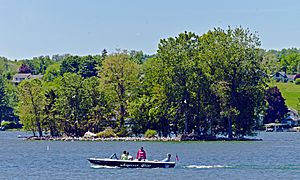Squaw Island (Canandaigua Lake) facts for kids

Squaw Island from Canandaigua City Pier
|
|
|
Location within New York
|
|
| Geography | |
|---|---|
| Coordinates | 42°52′12″N 77°16′32″W / 42.87000°N 77.27556°W |
| Adjacent bodies of water | Canandaigua Lake |
| Area | 8,000 sq ft (740 m2) |
| Length | 145 ft (44.2 m) |
| Width | 55 ft (16.8 m) |
| Administration | |
|
United States
|
|
| State | New York |
| County | Ontario |
| Town | Canandaigua |
Squaw Island is a tiny island located at the north end of Canandaigua Lake in New York, United States. It's close to the city of Canandaigua. This island is special because it's one of only two islands found in the 11 Finger Lakes.
Many people call Squaw Island New York's smallest state park. However, it's actually a "unique area." This means it's a protected natural space. The New York State Department of Environmental Conservation manages it.
The island was formed by sand and dirt carried by a nearby stream called Sucker Brook. The brook's water also carries dissolved limestone. This limestone forms rare, round rocks called "water biscuits" on the island's shores. Over time, the lake's water level has risen. This has made the island much smaller than it used to be. State officials and local groups are working hard to protect it from washing away.
Contents
Discover Squaw Island: Location and Size
Squaw Island is about 500 feet south of where Sucker Brook flows into the lake. It's also about 600 feet southwest of the docks in Canandaigua. Even though these nearby spots are in the city, the island itself is in the town of Canandaigua.
The water around the island is quite shallow, usually less than 25 feet deep. Sometimes, when the water is low, you might even be able to wade to the island from the shore!
The island is small, measuring about 145 feet long and 55 feet wide. Its total area is less than 8,000 square feet. Several large trees grow on the island. The edges are covered with piles of flat stones. The island's surface is mostly flat and sits just above the water. A large 10-ton granite rock sits in the middle of the island.
Island History: From Ice Age to Today
Canandaigua Lake and the other Finger Lakes were created about 11,000 years ago. This happened at the end of the last Ice Age. Melting glaciers filled deep valleys, forming these long, narrow lakes. Squaw Island started as a sandbar. It formed from the dirt and sand carried by Sucker Brook. Lake currents also helped shape it.
Before Europeans arrived, the island had two long gravel points. The nearby stream's delta made it easy to reach the island from land. You didn't need a boat, especially when the water was low.
Native American Connections
The first people to live in this area were the ancestors of the Iroquois Native American tribes. They didn't live on the island, even though it was bigger back then. However, flint arrowheads and other tools have been found there. This suggests the island was used for hunting birds and deer.
Some people believe the island got its name because Iroquois women used it as a safe place during the Revolutionary War. This was during the Sullivan Expedition of 1779. But since the island was easy to reach from shore, this story might not be true. It's more likely the name came from its use as a hunting and fishing spot. In recent years, some people have tried to change the island's name. The word "squaw" is now seen as an insensitive term.
The Mystery of Water Biscuits
In 1900, a scientist named John M. Clarke wrote about the unique "water biscuits" found on the island. These are disc-shaped white rocks. They are light and strong when wet but break easily when dry. Clarke explained how they form. Lime from the limestone bedrock dissolves in Sucker Brook. Tiny algae growing on pebbles use up carbon dioxide in the water. This causes the lime to harden around the pebbles, forming layers. This process repeats, creating the "biscuits." Clarke found this a fascinating example of how plants help create rock formations.
Protecting the Island
Clarke's paper interested Mary Clark Thompson. She was from Canandaigua and the daughter of a former New York governor. After her husband died, she used her money to help her community. She used her influence to protect Squaw Island. In 1918, the island was made a New York State Museum Reservation. This was done to keep it safe. The next year, she had the large granite boulder moved to the island's center. A special plaque was placed on it.
Throughout the 20th century, Squaw Island faced new challenges. Dams built on the Canandaigua Outlet raised the lake's water level. This put most of the island's gravel points underwater. In the late 1950s, the stream's delta was removed to make way for a marina. In 1975, the island became part of the state's Natural and Historic Preservation Trust.
Two years later, the state's Department of Environmental Conservation (DEC) tried to sell the island to the Town of Canandaigua. In the mid-1980s, the state worked to expand a state marine park. The DEC also placed cedar logs around the island. These efforts helped protect its shores from erosion. Today, the DEC calls the property the Squaw Island Unique Area. Local groups also continue to help protect this special island.
Images for kids



